engine TOYOTA PRIUS PLUG-IN HYBRID 2023 User Guide
[x] Cancel search | Manufacturer: TOYOTA, Model Year: 2023, Model line: PRIUS PLUG-IN HYBRID, Model: TOYOTA PRIUS PLUG-IN HYBRID 2023Pages: 818, PDF Size: 128.72 MB
Page 94 of 818

922-1. Plug-in hybrid system
Prius Plug-in Hybrid_OM_OM47F38E_(EE)
■When in HV mode
The vehicle can be used in the same way as a standard hybrid
vehicle.
In HV mode, controls are primarily carried out as follows in accor-
dance with the driving conditions.
●The gasoline engine stops
* when the vehicle is stopped.
●During start off, the electric motor (traction motor) drives the vehi-
cle.
●During normal driving, the gasoline engine and electric motor
(traction motor) are controlled effectively, and the vehicle is
driven with optimum fuel efficiency. Also, when necessary, the
electric motor (traction motor) operates as an electrical generator
to charge the hybrid battery (traction battery).
●When the accelerator pedal is depressed heavily, drive force
from both the gasoline engine and the electric motor (traction
motor) is used to accelerate.
*: When the hybrid battery (traction battery) requires charging or the
engine is warming up, etc., the gasoline engine will not automatically
stop. (P. 95)
■
When braking (regenerative braking)
The electric motor (traction motor) charges the hybrid battery (trac-
tion battery).
The EV driving range can be extended by actively using this regen-
erative braking to store electricity in the hybrid battery (traction bat-
tery).
Moreover, as fuel consumption is also reduced when in HV mode,
the regenerative braking system can be used effectively.
Page 95 of 818

932-1. Plug-in hybrid system
2
Plug-in hybrid system
Prius Plug-in Hybrid_OM_OM47F38E_(EE)
In order to make EV/EV City mode
available, charge the hybrid bat-
tery (traction battery) from an
external power source before
using the vehicle.
Even if charging the hybrid battery
(traction battery) has not been
completed, the vehicle can be
driven. However, if there is not
enough charge remaining, it is pos-
sible that the vehicle cannot be
driven in EV/EV City mode or the
EV driving range will become
shorter.
When driving with the gasoline engine stopped, a sound, which
changes in accordance with the driving speed, will be played in order
to warn people nearby of the vehicle’s approach. The sound will stop
when the vehicle speed exceeds approximately 25 km/h (16 mph).
■ Regenerative braking
● In the following situations, kinetic energy is converted to electric energy and
deceleration force can be obtained in c onjunction with the recharging of the
hybrid battery (traction battery).
• The accelerator pedal is released while driving with the shift position in
D or B.
• The brake pedal is depressed while driving with the shift position in D or
B.
● While the GPF system (P. 508) is operating to regenerate the exhaust gas
filter, the hybrid battery (traction battery) may not be recharged.
■ EV driving range
● The EV driving range is displayed on the multi-information display etc.
( P. 215, 231, 238, 255)
● The EV driving range changes in accordance with the charge status of the
hybrid battery (traction battery), the speed of the vehicle, etc.
● Even if there is enough charge remaining in the hybrid battery (traction bat-
tery), EV driving may be canceled and both gasoline engine and electric
motor are used depending on the situation. ( P. 9 4 )
Charging (P. 1 1 1 )
Vehicle proximity notification system
Page 96 of 818
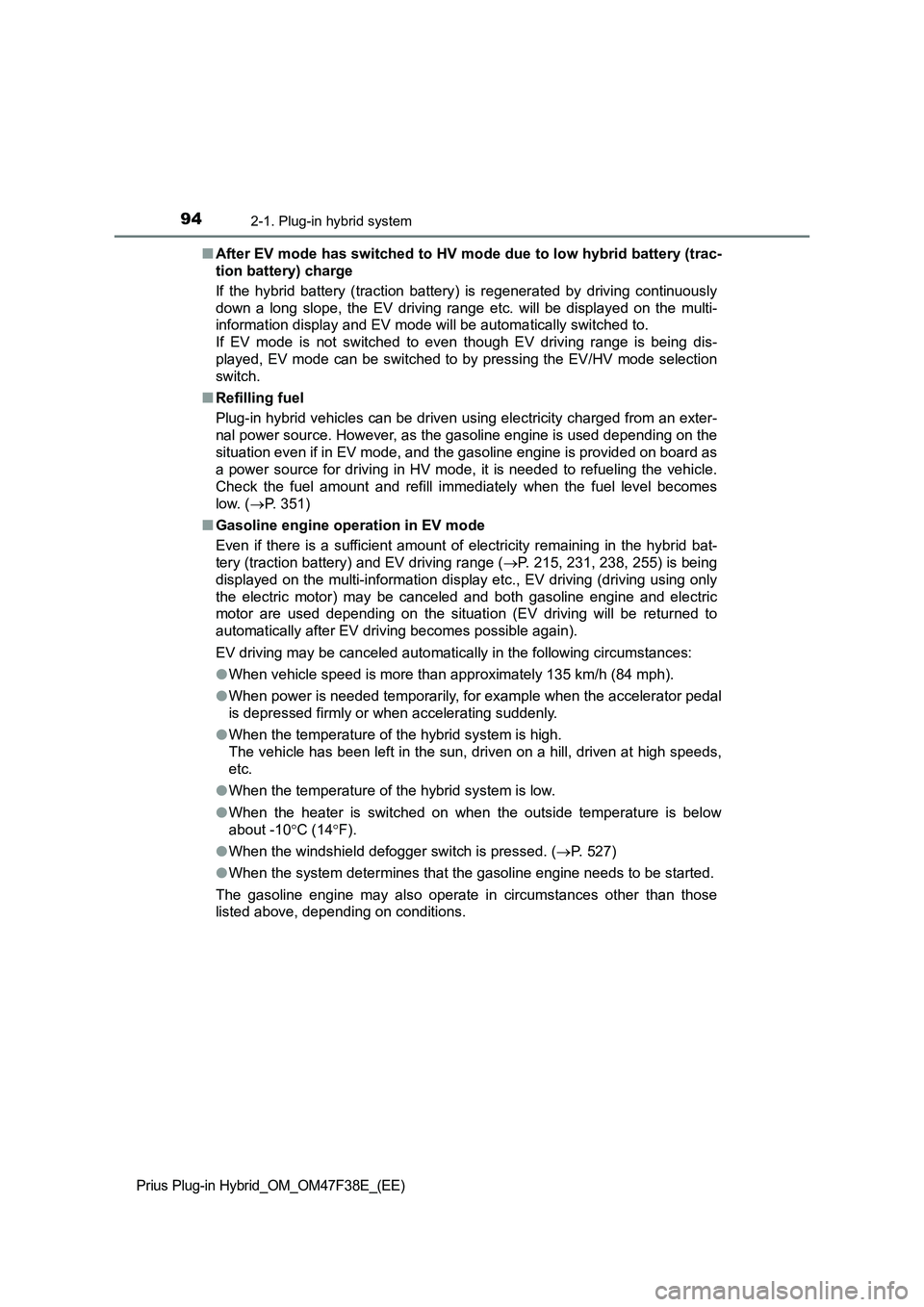
942-1. Plug-in hybrid system
Prius Plug-in Hybrid_OM_OM47F38E_(EE)
■After EV mode has switched to HV mode due to low hybrid battery (trac-
tion battery) charge
If the hybrid battery (traction battery) is regenerated by driving continuously
down a long slope, the EV driving range etc. will be displayed on the multi-
information display and EV mode will be automatically switched to.
If EV mode is not switched to even though EV driving range is being dis-
played, EV mode can be switched to by pressing the EV/HV mode selection
switch.
■Refilling fuel
Plug-in hybrid vehicles can be driven using electricity charged from an exter-
nal power source. However, as the gasoline engine is used depending on the
situation even if in EV mode, and the gasoline engine is provided on board as
a power source for driving in HV mode, it is needed to refueling the vehicle.
Check the fuel amount and refill immediately when the fuel level becomes
low. (P. 351)
■Gasoline engine operation in EV mode
Even if there is a sufficient amount of electricity remaining in the hybrid bat-
tery (traction battery) and EV driving range (P. 215, 231, 238, 255) is being
displayed on the multi-information display etc., EV driving (driving using only
the electric motor) may be canceled and both gasoline engine and electric
motor are used depending on the situation (EV driving will be returned to
automatically after EV driving becomes possible again).
EV driving may be canceled automatically in the following circumstances:
●When vehicle speed is more than approximately 135 km/h (84 mph).
●When power is needed temporarily, for example when the accelerator pedal
is depressed firmly or when accelerating suddenly.
●When the temperature of the hybrid system is high.
The vehicle has been left in the sun, driven on a hill, driven at high speeds,
etc.
●When the temperature of the hybrid system is low.
●When the heater is switched on when the outside temperature is below
about -10C (14F).
●When the windshield defogger switch is pressed. (P. 527)
●When the system determines that the gasoline engine needs to be started.
The gasoline engine may also operate in circumstances other than those
listed above, depending on conditions.
Page 97 of 818
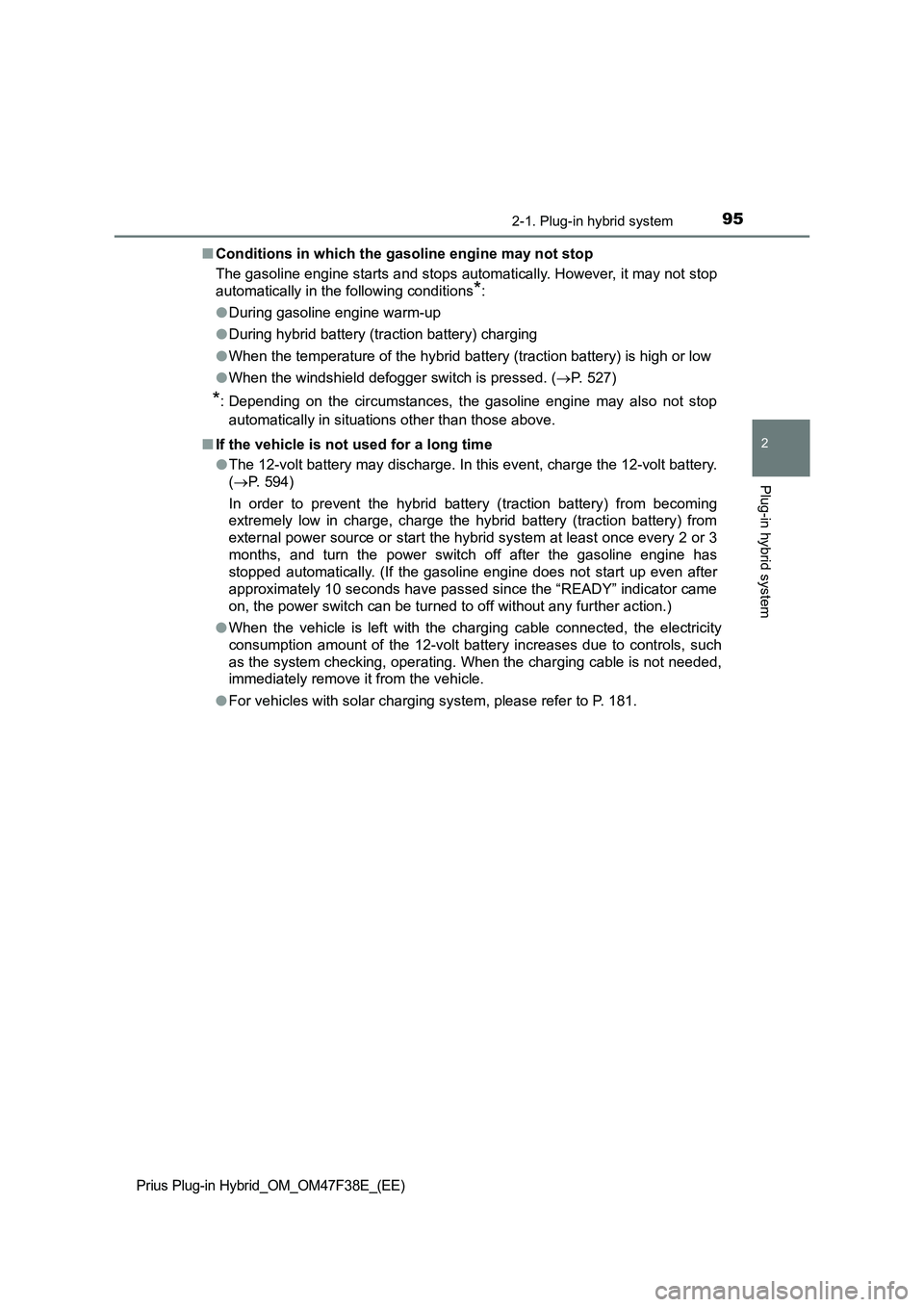
952-1. Plug-in hybrid system
2
Plug-in hybrid system
Prius Plug-in Hybrid_OM_OM47F38E_(EE)
■Conditions in which the gasoline engine may not stop
The gasoline engine starts and stops automatically. However, it may not stop
automatically in the following conditions
*:
●During gasoline engine warm-up
●During hybrid battery (traction battery) charging
●When the temperature of the hybrid battery (traction battery) is high or low
●When the windshield defogger switch is pressed. (P. 527)
*: Depending on the circumstances, the gasoline engine may also not stop
automatically in situations other than those above.
■If the vehicle is not used for a long time
●The 12-volt battery may discharge. In this event, charge the 12-volt battery.
(P. 594)
In order to prevent the hybrid battery (traction battery) from becoming
extremely low in charge, charge the hybrid battery (traction battery) from
external power source or start the hybrid system at least once every 2 or 3
months, and turn the power switch off after the gasoline engine has
stopped automatically. (If the gasoline engine does not start up even after
approximately 10 seconds have passed since the “READY” indicator came
on, the power switch can be turned to off without any further action.)
●When the vehicle is left with the charging cable connected, the electricity
consumption amount of the 12-volt battery increases due to controls, such
as the system checking, operating. When the charging cable is not needed,
immediately remove it from the vehicle.
●For vehicles with solar charging system, please refer to P. 181.
Page 98 of 818
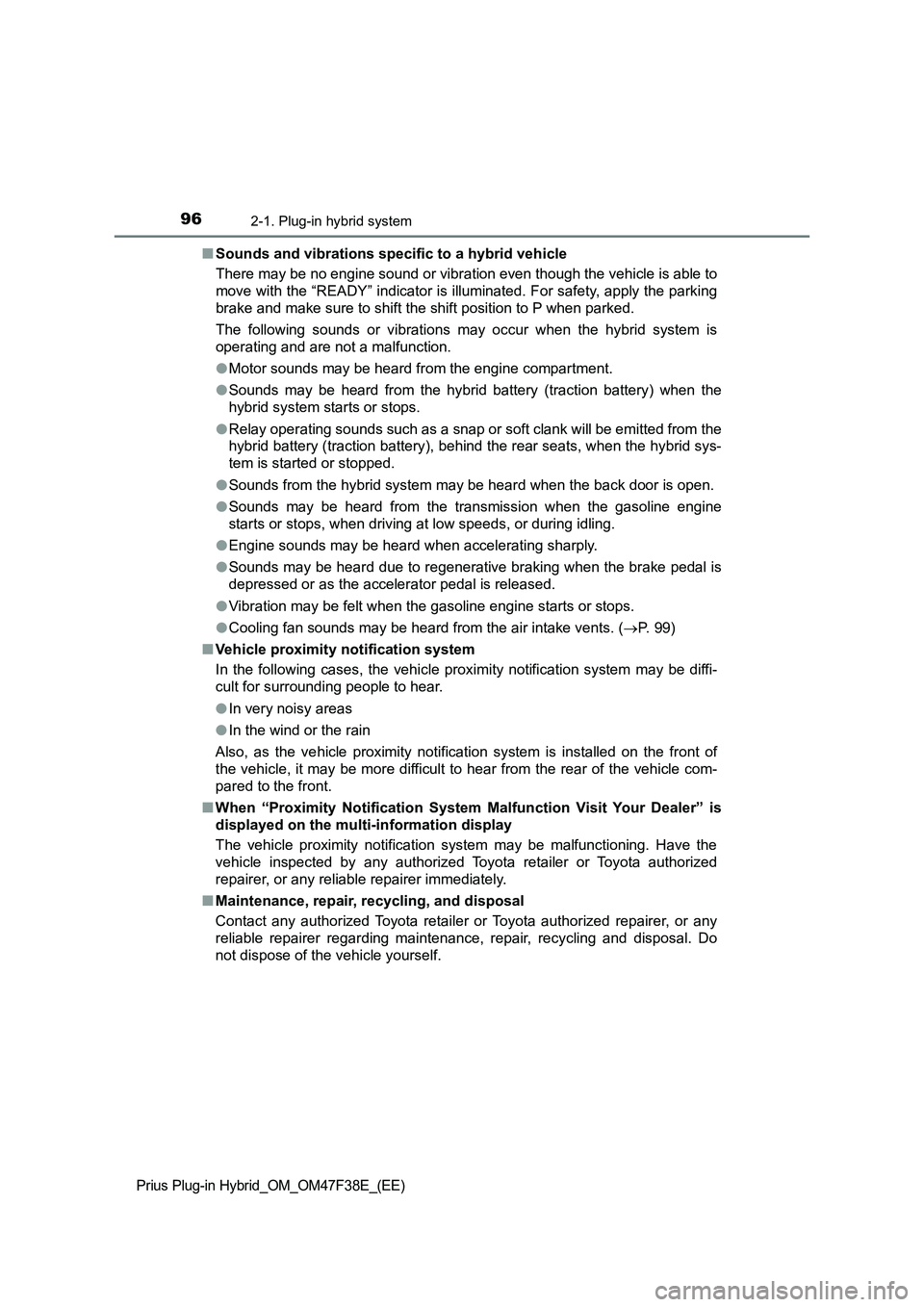
962-1. Plug-in hybrid system
Prius Plug-in Hybrid_OM_OM47F38E_(EE)
■Sounds and vibrations specific to a hybrid vehicle
There may be no engine sound or vibration even though the vehicle is able to
move with the “READY” indicator is illuminated. For safety, apply the parking
brake and make sure to shift the shift position to P when parked.
The following sounds or vibrations may occur when the hybrid system is
operating and are not a malfunction.
●Motor sounds may be heard from the engine compartment.
●Sounds may be heard from the hybrid battery (traction battery) when the
hybrid system starts or stops.
●Relay operating sounds such as a snap or soft clank will be emitted from the
hybrid battery (traction battery), behind the rear seats, when the hybrid sys-
tem is started or stopped.
●Sounds from the hybrid system may be heard when the back door is open.
●Sounds may be heard from the transmission when the gasoline engine
starts or stops, when driving at low speeds, or during idling.
●Engine sounds may be heard when accelerating sharply.
●Sounds may be heard due to regenerative braking when the brake pedal is
depressed or as the accelerator pedal is released.
●Vibration may be felt when the gasoline engine starts or stops.
●Cooling fan sounds may be heard from the air intake vents. (P. 99)
■Vehicle proximity notification system
In the following cases, the vehicle proximity notification system may be diffi-
cult for surrounding people to hear.
●In very noisy areas
●In the wind or the rain
Also, as the vehicle proximity notification system is installed on the front of
the vehicle, it may be more difficult to hear from the rear of the vehicle com-
pared to the front.
■When “Proximity Notification System Malfunction Visit Your Dealer” is
displayed on the multi-information display
The vehicle proximity notification system may be malfunctioning. Have the
vehicle inspected by any authorized Toyota retailer or Toyota authorized
repairer, or any reliable repairer immediately.
■Maintenance, repair, recycling, and disposal
Contact any authorized Toyota retailer or Toyota authorized repairer, or any
reliable repairer regarding maintenance, repair, recycling and disposal. Do
not dispose of the vehicle yourself.
Page 99 of 818

972-1. Plug-in hybrid system
2
Plug-in hybrid system
Prius Plug-in Hybrid_OM_OM47F38E_(EE)
WARNING
■When using the hybrid battery (traction battery) charge mode
Observe the following precautions when using the hybrid battery (traction
battery) charge mode while parking.
Failure to do so may lead to death or serious health hazard, as the gasoline
engine operates when in the hybrid battery (traction battery) charge mode.
● Do not stop the vehicle near flammable materials.
● Do not use the hybrid battery (traction battery) charge mode in a closed
area where ventilation is insufficient, such as in a garage or area with
snow buildup.
Page 106 of 818
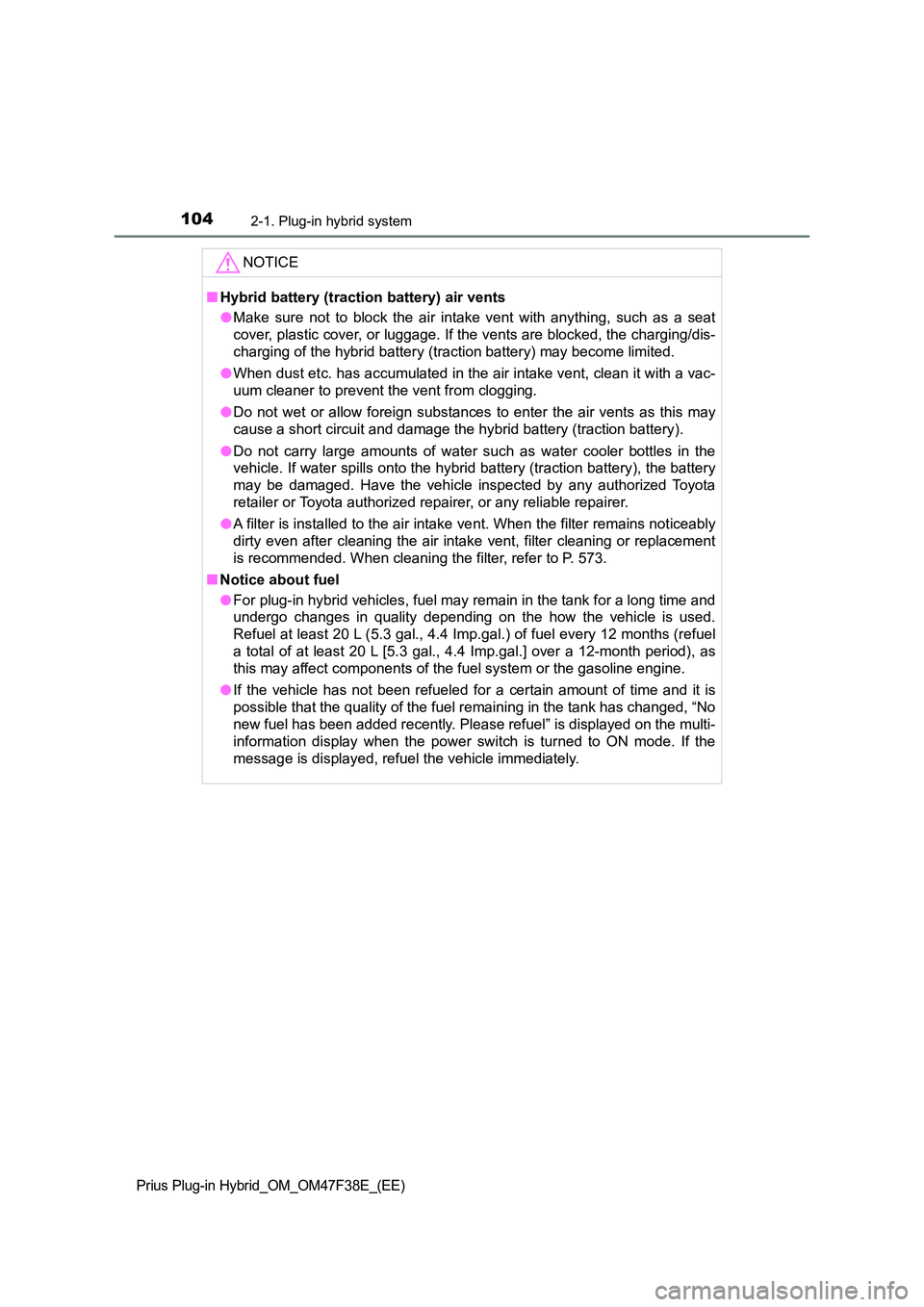
1042-1. Plug-in hybrid system
Prius Plug-in Hybrid_OM_OM47F38E_(EE)
NOTICE
■Hybrid battery (traction battery) air vents
● Make sure not to block the air intake vent with anything, such as a seat
cover, plastic cover, or luggage. If the vents are blocked, the charging/dis-
charging of the hybrid battery (traction battery) may become limited.
● When dust etc. has accumulated in the air intake vent, clean it with a vac-
uum cleaner to prevent the vent from clogging.
● Do not wet or allow foreign substances to enter the air vents as this may
cause a short circuit and damage the hybrid battery (traction battery).
● Do not carry large amounts of water such as water cooler bottles in the
vehicle. If water spills onto the hybrid battery (traction battery), the battery
may be damaged. Have the vehicle inspected by any authorized Toyota
retailer or Toyota authorized repairer, or any reliable repairer.
● A filter is installed to the air intake vent. When the filter remains noticeably
dirty even after cleaning the air intake vent, filter cleaning or replacement
is recommended. When cleaning the filter, refer to P. 573.
■ Notice about fuel
● For plug-in hybrid vehicles, fuel may remain in the tank for a long time and
undergo changes in quality depending on the how the vehicle is used.
Refuel at least 20 L (5.3 gal., 4.4 Imp.gal.) of fuel every 12 months (refuel
a total of at least 20 L [5.3 gal., 4.4 Imp.gal.] over a 12-month period), as
this may affect components of the fuel system or the gasoline engine.
● If the vehicle has not been refueled for a certain amount of time and it is
possible that the quality of the fuel remaining in the tank has changed, “No
new fuel has been added recently. Please refuel” is displayed on the multi-
information display when the power switch is turned to ON mode. If the
message is displayed, refuel the vehicle immediately.
Page 107 of 818
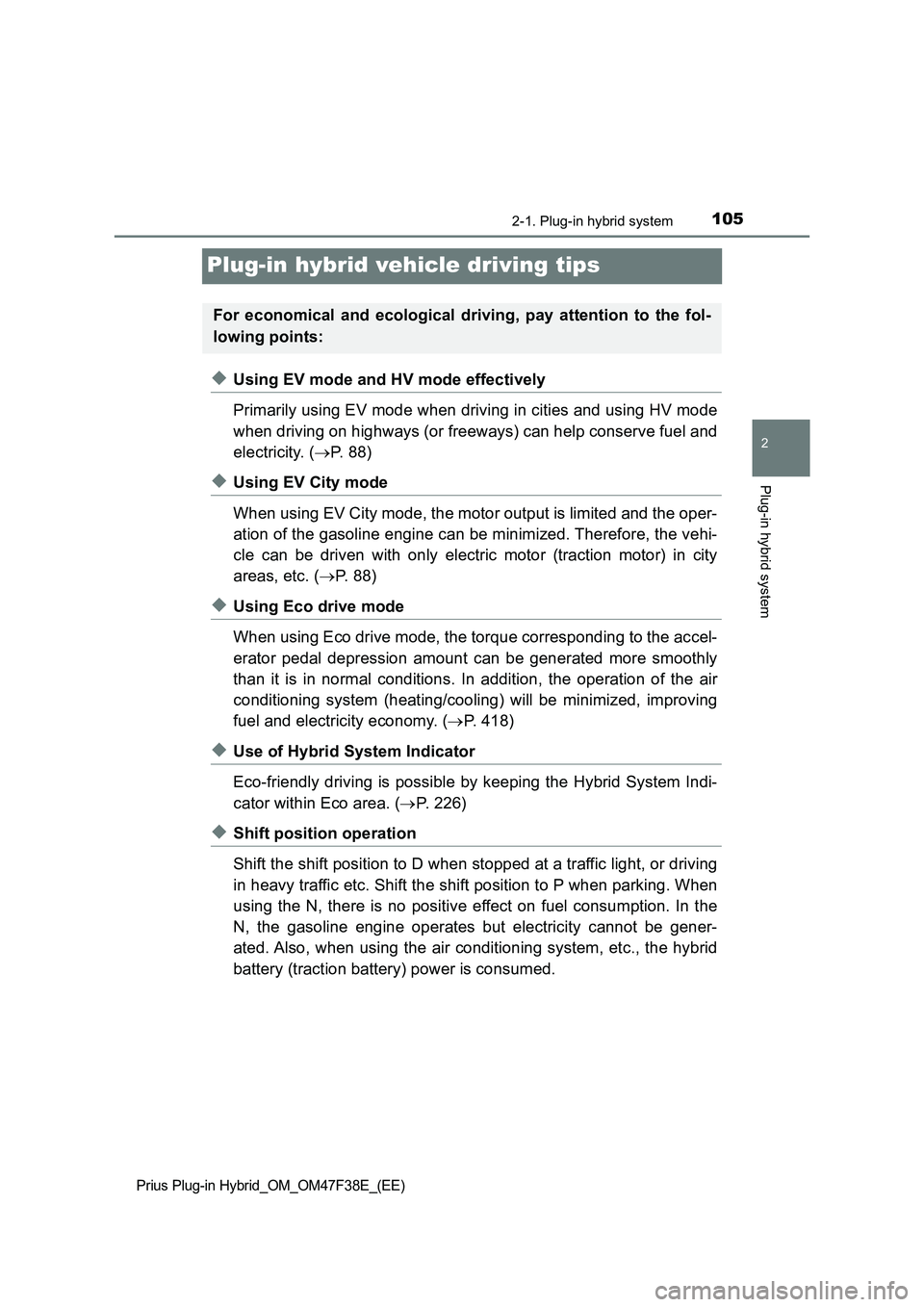
105
2
2-1. Plug-in hybrid system
Plug-in hybrid system
Prius Plug-in Hybrid_OM_OM47F38E_(EE)
Plug-in hybrid vehicle driving tips
◆Using EV mode and HV mode effectively
Primarily using EV mode when driving in cities and using HV mode
when driving on highways (or freeways) can help conserve fuel and
electricity. (P. 88)
◆Using EV City mode
When using EV City mode, the motor output is limited and the oper-
ation of the gasoline engine can be minimized. Therefore, the vehi-
cle can be driven with only electric motor (traction motor) in city
areas, etc. (P. 88)
◆Using Eco drive mode
When using Eco drive mode, the torque corresponding to the accel-
erator pedal depression amount can be generated more smoothly
than it is in normal conditions. In addition, the operation of the air
conditioning system (heating/cooling) will be minimized, improving
fuel and electricity economy. (P. 418)
◆Use of Hybrid System Indicator
Eco-friendly driving is possible by keeping the Hybrid System Indi-
cator within Eco area. (P. 226)
◆Shift position operation
Shift the shift position to D when stopped at a traffic light, or driving
in heavy traffic etc. Shift the shift position to P when parking. When
using the N, there is no positive effect on fuel consumption. In the
N, the gasoline engine operates but electricity cannot be gener-
ated. Also, when using the air conditioning system, etc., the hybrid
battery (traction battery) power is consumed.
For economical and ecological driving, pay attention to the fol-
lowing points:
Page 108 of 818
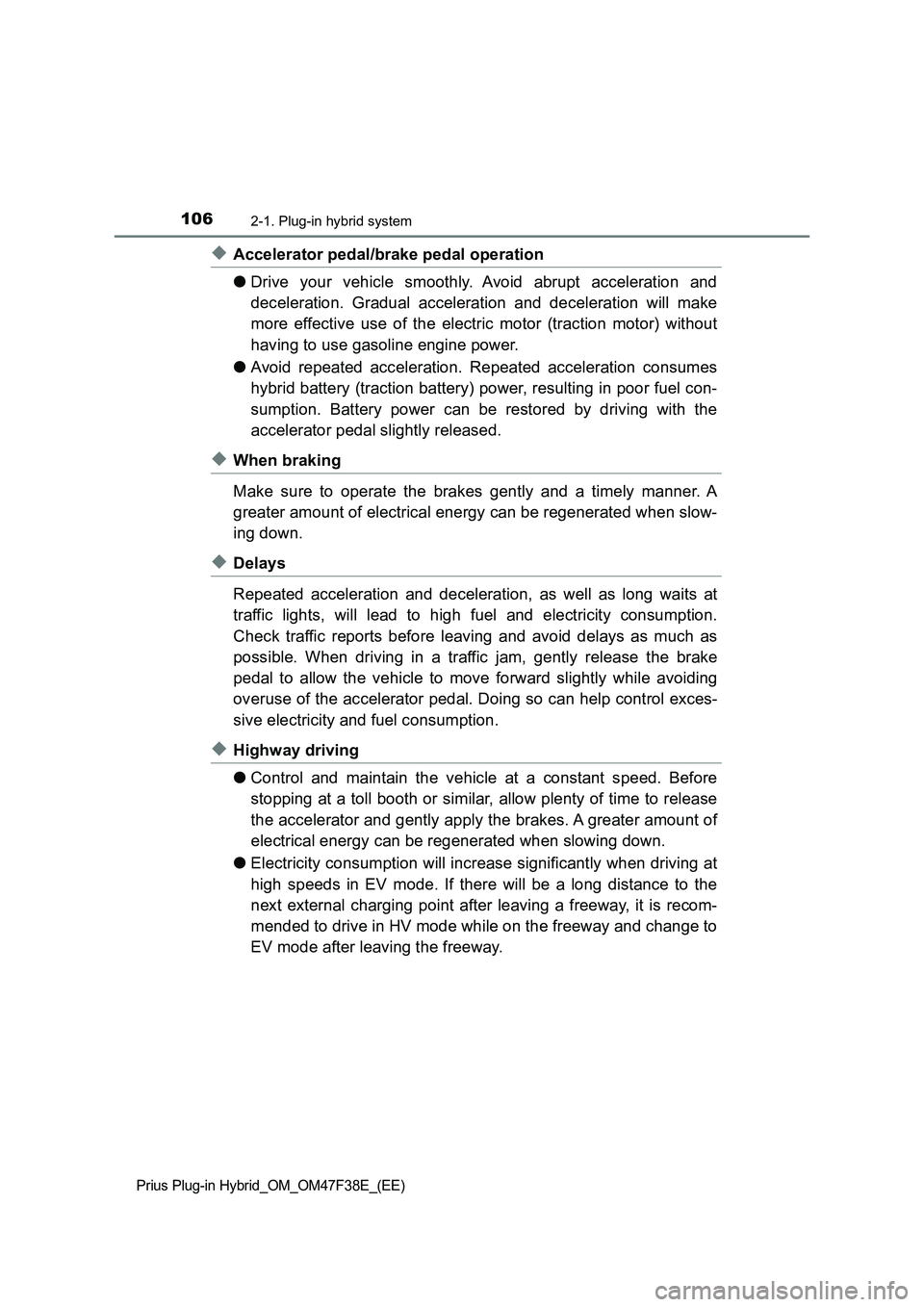
1062-1. Plug-in hybrid system
Prius Plug-in Hybrid_OM_OM47F38E_(EE)
◆Accelerator pedal/brake pedal operation
●Drive your vehicle smoothly. Avoid abrupt acceleration and
deceleration. Gradual acceleration and deceleration will make
more effective use of the electric motor (traction motor) without
having to use gasoline engine power.
●Avoid repeated acceleration. Repeated acceleration consumes
hybrid battery (traction battery) power, resulting in poor fuel con-
sumption. Battery power can be restored by driving with the
accelerator pedal slightly released.
◆When braking
Make sure to operate the brakes gently and a timely manner. A
greater amount of electrical energy can be regenerated when slow-
ing down.
◆Delays
Repeated acceleration and deceleration, as well as long waits at
traffic lights, will lead to high fuel and electricity consumption.
Check traffic reports before leaving and avoid delays as much as
possible. When driving in a traffic jam, gently release the brake
pedal to allow the vehicle to move forward slightly while avoiding
overuse of the accelerator pedal. Doing so can help control exces-
sive electricity and fuel consumption.
◆Highway driving
●Control and maintain the vehicle at a constant speed. Before
stopping at a toll booth or similar, allow plenty of time to release
the accelerator and gently apply the brakes. A greater amount of
electrical energy can be regenerated when slowing down.
●Electricity consumption will increase significantly when driving at
high speeds in EV mode. If there will be a long distance to the
next external charging point after leaving a freeway, it is recom-
mended to drive in HV mode while on the freeway and change to
EV mode after leaving the freeway.
Page 110 of 818

1082-1. Plug-in hybrid system
Prius Plug-in Hybrid_OM_OM47F38E_(EE)
◆Luggage
Carrying heavy luggage will lead to poor fuel economy. Avoid carry-
ing unnecessary luggage. Installing a large roof rack will also cause
poor fuel economy.
◆Warming up before driving
Since the gasoline engine starts up and cuts out automatically,
warming up is not necessary.
◆While warming up the engine
The hybrid system output may be restrained.